Sabiha Gökçen
| Sabiha Gökçen | |
|---|---|
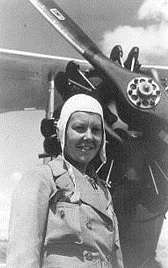 | |
| Born |
22 March 1913 Bursa, Hüdavendigâr Vilayet, Ottoman Empire |
| Died |
22 March 2001 (aged 88) Ankara, Turkey |
| Alma mater | Uskudar American Academy. |
| Occupation | Aviator, author and spokesperson |
| Known for | First Turkish woman to fly during conflict. |
| Parent(s) | Mustafa İzzet Bey and Hayriye Hanım |
Sabiha Gökçen (Turkish: [sabiha ɡøkt͡ʃen]; 22 March 1913 – 22 March 2001)[1] was a Turkish aviator. She was the first Turkish female combat pilot, aged 23.[2] According to some sources, including Guinness World Records,[3] she was also the world's first female fighter pilot, being enrolled in the Military Aviation Academy in Eskisehir in 1936. However, others such as Marie Marvingt[4][5] and Eugenie Mikhailovna Shakhovskaya[6][7][8] preceded her as military pilots in other roles, probably without a military academy enrollment. She was one of the eight adopted children of Mustafa Kemal Atatürk.
Gökçen made headlines and sparked controversy, in 2004, when Hrant Dink, a journalist of Turkish-Armenian descent, published an interview with a person claiming to be Sabiha's niece that claimed that she was of Armenian origin. Her adopted sister Ülkü Adatepe disputed this during an interview, claiming that Sabiha was of Bosniak ancestry.[9]
Early life
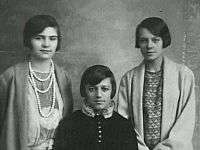

Sabiha Gökçen's Bosniak or Armenian origins are a matter of some dispute. According to official Turkish sources and interviews with Sabiha Gökçen, she was the daughter of Mustafa Izzet Bey and Hayriye Hanım, both of whom were of Bosniak origin.[10] During Atatürk's visit to Bursa in 1925, Sabiha, who was only twelve years old, asked for permission to talk with Atatürk and expressed her wish to study in a boarding school. After learning her story and about her miserable living conditions, Atatürk decided to adopt her and asked Sabiha's brother for permission to take her to the Çankaya Presidential Residence in Ankara, where Sabiha would live among Atatürk's other adoptive daughters, Zehra, Afet and Rukiye. Sabiha attended the Çankaya Primary School in Ankara and the Üsküdar American Academy in Istanbul.
In February 2004 an article in the newspaper Agos, headlined "The Secret of Sabiha Hatun", contained an interview with Hripsime Sebilciyan, a former Gaziantep resident, who claimed to be Gökçen's niece and that Gökçen herself was of Armenian ancestry.[11] Mustafa Kemal took a liking to Sebilciyan, who was in an orphanage shortly after the Armenian Genocide, and had her adopted.[12] According to historian Pars Tuğlacı, Gökçen herself found out about her Armenian identity while in Ankara, when members of her family contacted her from Beirut.[13] Gökçen reportedly visited her Armenian relatives in Beirut. She had four brothers, Sarkis, Boğos, Haçik and Hovhannes.[14]
However, along with Turkish sources and interviews with Sabiha, her adopted sister Ülkü Adatepe, also in an interview, disputed these claims of Armenian origin and reiterated that Sabiha and her both parents, Mustafa Izzet Bey and Hayriye Hanim, were of Bosniak ancestry.[9][10][15]
Just after the introduction of the Surname Law, Atatürk gave her the family name Gökçen on 19 December 1934. 'Gök' means sky in Turkish and Gökçen means 'belonging or relating to the sky'. However, she was not an aviator at that time,[16][17] and it was only six months later that Sabiha developed a passion for flying.
Career
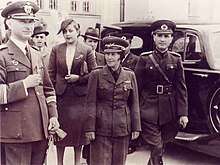
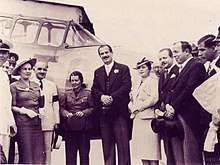
Atatürk attached great importance to aviation and for that purpose oversaw the foundation of the Turkish Aeronautical Association in 1925. He took Sabiha along with him to the opening ceremony of Türkkuşu (Turkishbird) Flight School on 5 May 1935. During the airshow of gliders and parachutists invited from foreign countries, she got very excited. As Atatürk asked her whether she would also want to become a skydiver, she nodded "yes indeed, I am ready right now". Atatürk instructed Fuat Bulca, the head of the school, to enroll her as the first female trainee. She was meant to become a skydiver, but she was much more interested in flying, so she received her pilot's licence. Gökçen was sent to Russia, together with seven male students, for an advanced course in glider and powered aircraft piloting. However, when she was in Moscow, she learned the news that Zehra had died, and with collapsed morale, she immediately returned to Turkey, isolating herself from social activities for some time.
As girls were not being accepted by the War College in Turkey in those years, Sabiha Gökçen was provided, on Atatürk's orders, with a personalized uniform, and attended a special education programme of eleven months at the Tayyare Mektebi (Aviation School) in Eskişehir in the academic year 1936-1937. After receiving her flight patents (diploma) she trained to become a war pilot at the 1st Airplane Regiment in Eskişehir for six months.
She improved her skills by flying bomber and fighter planes at the 1st Aircraft Regiment in Eskişehir Airbase and got experience after participating in the Aegean and Thrace exercises in 1937. In that same year, she took part in the Dersim rebellion and became the first Turkish female air force combat pilot. A report of the General Staff mentioned the "serious damage" that had been caused by her 50 kg bomb to a group of fifty fleeing "bandits."[18] and she was awarded with a takdirname (letter of appreciation). She was also awarded the Turkish Aeronautical Association's first "Murassa (Jeweled) Medal" for her superior performance in this operation.[16]
In 1938, she carried out a five-day flight around the Balkan countries to great acclaim. In the same year, she was appointed "chief trainer" of the Türkkuşu Flight School of the Turkish Aeronautical Association, where she served until 1954 as a flight instructor[16] and became a member of the association's executive board. She trained four female aviators, Edibe Subaşı, Yıldız Uçman, Sahavet Karapas and Nezihe Viranyalı. Sabiha Gökçen flew around the world for a period of 28 years until 1964. Her book entitled "A Life Along the Path of Atatürk" was published in 1981 by the Turkish Aeronautical Association to commemorate Atatürk's 100th birthday.
Throughout her career in the Turkish Air Force, Gökçen flew 22 different types of aircraft for more than 8,000 hours, 32 hours of which were active combat and bombardment missions.[19]
Controversies

After the 2004 article "The Secret of Sabiha Hatun" said that Sabiha had an Armenian origin, many contested the matter, including the last living daughter of Atatürk, Ülkü Adatepe, who disputed the claim during an interview.[20][21][22] According to Adatepe, Sabiha's mother Hayriye was an ethnic Bosniak.[9] The mere notion that Gökçen could have been Armenian caused an uproar throughout Turkey; the Turkish General Staff said the debate "mocked national values" and was "not conducive to social peace".[23] Hrant Dink, the journalist who wrote the article, came under fire, most notably from newspaper columnists and Turkish ultra-nationalist groups, which labeled him a traitor.[24] A US consul dispatch leaked by WikiLeaks and penned by an official from the consulate in Istanbul observed that the entire affair "exposed an ugly streak of racism in Turkish society."[24] It is also believed that the affair was one of the reasons that led to Hrant Dink's assassination in Istanbul in January 2007, by Ogün Samast, a 17-year-old Turkish nationalist.[25][26][27]
Legacy and recognition
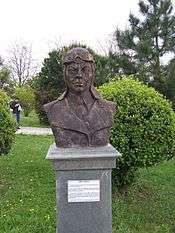
Sabiha Gökçen International Airport in Istanbul is named after her.
She is recognized as the first female combat pilot by The Guinness Book of World Records.[3]
She was selected as the only female pilot for the poster of "The 20 Greatest Aviators in History" published by the United States Air Force in 1996.[19]
She was the subject of a Google Doodle honouring her birthday which was displayed in Turkey on 22 March 2009.[28]
See also
References
- ↑ http://www.ntv.com.tr/turkiye/sabiha-gokcen-google-ana-sayfasinda,84NXBXk620mwTL0rKrwfSA
- ↑ Naughton, Russell (2014). "Sabiha Gokcen (1913-2001), Pioneer Aviatrix". Hargrave Pioneers of Aviation. Retrieved 17 November 2014.
- 1 2 "First Female Combat Pilot". Guinness World Records Official Web Site. Retrieved 15 May 2016.
- ↑ "1915 - First woman pilot in combat missions as a bomber pilot - Marie Marvingt (France)". Centennial of Women Pilots. Retrieved 10 January 2015.
In 1915, Marvingt became the first woman in the world to fly combat missions when she became a volunteer pilot flying bombing missions over German-held territory and she received the Croix de Guerre (Military Cross) for her aerial bombing of a German military base in Metz.
- ↑ Historic Wings – Online Magazine; Article on Hélène Dutrieu Coupe Femina and Marie Marvingt:, Published on December 21, 2012: http://fly.historicwings.com/2012/12/helene-dutrieux-and-the-coupe-femina Retrieved 10 January 2015.
- ↑ Lawson, Eric and Jane (1996). The First Air Campaign: August 1914- November 1918. Da Capo Press. p. 56. ISBN 0-306-81213-4.
Eugenie Shakhovskaya, a 25 year old Russian princess, was the first female fighter pilot in history.
- ↑ "Women Combat Pilots of WW1". Monash University. Retrieved 10 January 2015.
Princess Eugenie M. Shakhovskaya was Russia's first woman military pilot. Served with the 1st Field Air Squadron. Unknown if she actually flew any combat missions, and she was ultimately charged with treason and attempting to flee to enemy lines. Sentenced to death by firing squad, sentence commuted to life imprisonment by the Tsar, freed during the Revolution, became chief executioner for Gen. Tchecka and drug addict, shot one of her assistants in a narcotic delirium and was herself shot.
- ↑ "300 Women who changed the world". Encyclopædia Britannica. Retrieved 10 January 2015.
In Russia, Princess Eugenie Shakhovskaya is the first female military pilot. She flies reconnaissance missions.
- 1 2 3 Koser, Mutlu (23 February 2004). "İşte soyağacı". Hürriyet. Archived from the original on 2 Apr 2015. Retrieved 13 July 2008.
- 1 2 "Ataturk's Daughter was an Armenian". armedia.am. 2 November 2016. Retrieved 17 May 2017.
According to Turkish sources and the interview with Sabiha Gokcen herself, she was born on March 22, 1913 in Bursa. She was the daughter of Mustafa Izzet Bey and Hayriye Hanim who were ethnic Bosniaks.
- ↑ Dink, Hrant (6 February 2004). "Sabiha Hatun'un Sırrı". Agos.
- ↑ Morris, Chris (1 May 2014). The New Turkey: The Quiet Revolution On The Edge Of Europe. Granta Publications. ISBN 978-1-78378-031-0.
- ↑ "Gökçen Ermeni’ydi". Hürriyet (in Turkish). 22 February 2004.
- ↑ Bal, Ali (16 April 2010). "Sabiha Gökçen et la controverse sur ses origines" (in French). Turquie News.
- ↑ Fatma, Ulgen, (1 January 2010). ""Sabiha Gök̨cen's 80-year-old secret" : Kemalist nation formation and the Ottoman Armenians" (.pdf). eScholarship. Retrieved 18 May 2017.
- 1 2 3 "Dünyanın İlk Kadın Savaş Pilotu: Sabiha Gökçen" [The world's first female combat pilot: Sabiha Gökçen]. Türk Hava Kuvvetleri (in Turkish). 2014. Retrieved 17 November 2014.
- ↑ Atatürk, Kemal (1 January 1998). Atatürk'ün bütün eserleri [Ataturk's Complete Works] (in Turkish). 27. Kaynak Yayınları. p. 109. ISBN 978-975-343-235-1.
- ↑ Hallı, Reşat (1972). Türkiye Cumhuriyetinde Ayaklanmalar (1924–1938) [The Rebellions in the Republic of Turkey, 1924-1938] (in Turkish). T. C. Genelkurmay Baskanlığı Harp Tarihi Dairesi. p. 382.
- 1 2 TRT documentary on Sabiha Gökçen on YouTube. See 9m30s in for 1996 USAF poster claim.
- ↑ Tekin, Hüseyin (28 February 2004). "Sabiha Gökçen tartışmasında kim ne yazdı". Hürriyet (in Turkish). Retrieved 13 July 2008.
- ↑ Morgan, Tabitha (29 February 2004). "Turkish heroine's roots spark row". BBC News.
- ↑ Bureau of Democracy, Human Rights, and Labor (28 February 2005). "2004 Country Report on Human Rights Practices in Turkey". Country Reports on Human Rights Practices. US State Department. Retrieved 25 July 2008.
In February, the Hurriyet newspaper's publication of a report that Sabiha Gokcen--an adopted daughter of Mustafa Kemal Ataturk, who was the country's first female pilot--was of Armenian descent drew a number of racist public statements. The Turkish General Staff issued a statement criticizing the reports on Gokcen's Armenian ancestry as 'a claim that abuses national values and feelings' while the Turkish Air Association called the report 'an insult' to Gokcen and to Ataturk.
- ↑ Turkish heroine's roots spark row
- 1 2 "Cable reference id: #04ISTANBUL374". web.archive.org. 10 March 2004. Archived from the original on 9 December 2013. Retrieved 17 November 2014.
- ↑ Insel, Ahmet (28 February 2009). ""Bu Hareket Beşeriyet Namına Bir Cinayetti": Ermenilerden Özür Dileme Girişiminin Değerlendirilmesi" (in Turkish). Birikim.
- ↑ Kemal Cengiz, Orhan (15 January 2010). "The ‘smoke’ which killed Hrant Dink". Zaman.
- ↑ Göktaş, Kemal (2009). Hrant Dink cinayeti: medya, yargı, devlet (1. baskı. ed.). İstanbul: Güncel Yayıncılık. ISBN 9944840491.
- ↑ "Sabiha Gökçen's Birthday". Google Doodles Archive. 2014. Retrieved 17 November 2014.
External links
-
 Media related to Sabiha Gökçen at Wikimedia Commons
Media related to Sabiha Gökçen at Wikimedia Commons - Atatürk Arşivi - Sabiha Gökçen: Part 1Part 2Part 3Part 4Part 5Part 6